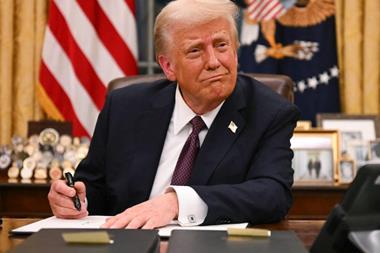Donald Trump, the US president-elect, has vowed to impose a 25% tariff on all goods being imported into the country from Mexico and Canada, deepening fears for the automotive industry in North America and threatening the trend of nearshoring.

Trump has said he will sign an executive order to impose the tariffs after being inaugurated in January next year. As well as placing the 25% tariff on all goods coming from Mexico and Canada, he added that he will be adding an additional 10% to Chinese goods.
The move was not targeted directly at the automotive industry – in fact, in his post on Truth Social, he said the tariffs would remain until Mexico and Canada tackle alleged drug trade – but it will affect the automotive supply chain and the logistics networks that run across North America, if the tariffs are indeed imposed from 20 January.
If held up, the tariffs would break the US-Mexico-Canada Trade Agreement (USMCA), which was set to remain in place until its review in 2026. The USMCA deal replaced the North American Free Trade Agreement (NAFTA) which was previously in place.
Read more: USMCA timeline and trade relations
It is not yet known whether the tariffs would apply to just finished vehicles or all parts and materials used in the vehicle. If the latter is the case, it could be massively detrimental to the North American automotive supply chain, as the US-Mexico border is crossed multiple times in logistics before a finished vehicle is produced.
How Trump’s tariffs could disrupt Mexico’s automotive supply chain
Earlier this month, Mike Wall executive director, automotive analysis at S&P told Automotive Logistics that trade between Mexico and the US has been ingrained and entrenched over the last two decades. “There are components that cross the US-Mexico border multiple times before they get installed in a vehicle,” Wall said. And according to experts at this year’s ALSC Mexico conference, Mexico is estimated to supply up to 40% of value of parts in US-built vehicles.
At the conference, Francisco N. González Díaz, executive president, Industria Nacional de Autopartes said: “Every move that Trump and the new administration will make will [affect this] hotspot the automotive industry. This hotspot is the backbone of the free trade agreement, because of the parts that the US buy worldwide, 43% come from Mexico. The second supplier is Canada with 11%, and the third is Japan with 9%. If you want to change your suppliers in this sector you have to develop them for the next 10 years. This is a very strong backbone.”
With such a high percentage of finished vehicle value coming from Mexico and Canada, it is difficult to predict how the tariffs could be implemented without causing devastation to the whole North American supply chain as we know it.
Trump’s tariffs and the risk of violating the USMCA deal
If implemented, Trump’s tariffs would violate the USMCA. While it is up for review in 2026, it could take years for negotiations to be resolved, meaning the agreement is meant to be upheld for at least the first year of Trump’s term.

If the USMCA falls apart, it could spell problems for investment in nearshoring. At ALSC Mexico 2024, Lizette Gracida, senior director of external affairs & trade compliance at Toyota México attributed investment in Mexico’s automotive supply chain in part to the agreement.
“Nearshoring is not a new phenomenon for Mexico nor for the auto industry. Before NAFTA entered into force back in the 1990’s there were only five OEMs in the country.
Watch: Toyota México’s Lizette Gracida on the Red Sofa
“After the agreement was signed, Japanese, German and Korean carmakers started arriving to the country and not only the auto makers but also an extensive network of suppliers,” she said.
“This new wave of nearshoring has been determined by two factors in our view, the first one is the geopolitical situation between the US and China, and the second one is the USMCA,” she added. “That by itself promotes the further integration of the value chain in the region.”
Claudia Ávila Connelly, international trade, nearshoring & economic development expert said: “We are scared about the expectations of president Trump against Mexico, but I believe in our interdependency, because the US needs us.”
ALSC Mexico 2024: Investment in nearshoring continues in Mexico’s automotive supply chain
At the time, she added: “I believe that in real terms, trade will continue. It’s not that I want to be optimistic, but we are the first partner of the US and we have to be positive and do what we can on our side to comply with regulations and comply with the USMCA.”
We will update this story as we hear more…

























![Global[1]](https://d3n5uof8vony13.cloudfront.net/Pictures/web/a/d/s/global1_726550.svgz)















No comments yet